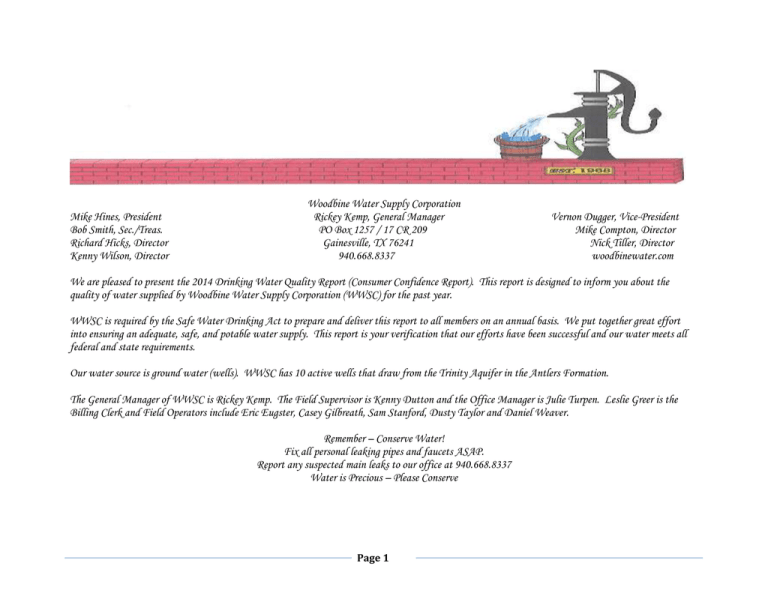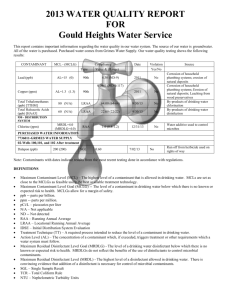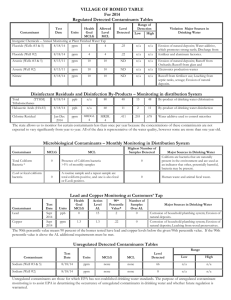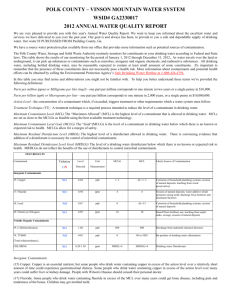Annual Drinking Water Quality Report 2014. DOC
advertisement

Mike Hines, President Bob Smith, Sec./Treas. Richard Hicks, Director Kenny Wilson, Director Woodbine Water Supply Corporation Rickey Kemp, General Manager PO Box 1257 / 17 CR 209 Gainesville, TX 76241 940.668.8337 Vernon Dugger, Vice-President Mike Compton, Director Nick Tiller, Director woodbinewater.com We are pleased to present the 2014 Drinking Water Quality Report (Consumer Confidence Report). This report is designed to inform you about the quality of water supplied by Woodbine Water Supply Corporation (WWSC) for the past year. WWSC is required by the Safe Water Drinking Act to prepare and deliver this report to all members on an annual basis. We put together great effort into ensuring an adequate, safe, and potable water supply. This report is your verification that our efforts have been successful and our water meets all federal and state requirements. Our water source is ground water (wells). WWSC has 10 active wells that draw from the Trinity Aquifer in the Antlers Formation. The General Manager of WWSC is Rickey Kemp. The Field Supervisor is Kenny Dutton and the Office Manager is Julie Turpen. Leslie Greer is the Billing Clerk and Field Operators include Eric Eugster, Casey Gilbreath, Sam Stanford, Dusty Taylor and Daniel Weaver. Remember – Conserve Water! Fix all personal leaking pipes and faucets ASAP. Report any suspected main leaks to our office at 940.668.8337 Water is Precious – Please Conserve Page 1 Annual Drinking Water Quality Report TX0490018 Woodbine WSC For more information regarding this report contact: Annual Water Quality Report for the period of January 1 to December 31, 2014 Rickey D Kemp, General Manager 940.668.8337 Public participation concerning this Consumer Confidence Report will be at 7:00 p.m. on July 13, 2015 at our office located at 17 CR 209, Gainesville, Texas. This report is intended to provide you with important information about your drinking water and the efforts made by the water system to provide safe drinking water. Este reporte incluye información importante sobre el agua para tomar. WOODBINE WSC’s source water is ground water from the Trinity Aquifer in the Antlers Formation Para asistencia en español, favor de llamar al telefono (940) 668-8337. Sources of Drinking Water The sources of drinking water (both tap water and bottled water) include rivers, lakes, streams, ponds, reservoirs, springs, and wells. As water travels over the surface of the land or through the ground, it dissolves naturally-occurring minerals and, in some cases, radioactive material, and can pick up substances resulting from the presence of animals or from human activity. Drinking water, including bottled water, may reasonably be expected to contain at least small amounts of some contaminants. The presence of contaminants does not necessarily indicate that water poses a health risk. More information about contaminants and potential health effects can be obtained by calling the EPAs Safe Drinking Water Hotline at (800) 426-4791. Contaminants that may be present in source water include: - Microbial contaminants, such as viruses and bacteria, which may come from sewage treatment plants, septic systems, agricultural livestock operations, and wildlife. - Inorganic contaminants, such as salts and metals, which can be naturally-occurring or result from urban storm water runoff, industrial or domestic wastewater discharges, oil and gas production, mining, or farming. Page 2 - Pesticides and herbicides, which may come from a variety of sources such as agriculture, urban storm water runoff, and residential uses. - Organic chemical contaminants, including synthetic and volatile organic chemicals, which are by-products of industrial processes and petroleum production, and can also come from gas stations, urban storm water runoff, and septic systems. - Radioactive contaminants, which can be naturally-occurring or be the result of oil and gas production and mining activities. In order to ensure that tap water is safe to drink, EPA prescribes regulations which limit the amount of certain contaminants in water provided by public water systems. FDA regulations establish limits for contaminants in bottled water which must provide the same protection for public health. Contaminants may be found in drinking water that may cause taste, color, or odor problems. These types of problems are not necessarily causes for health concerns. For more information on taste, odor, or color of drinking water, please contact the system's business office. You may be more vulnerable than the general population to certain microbial contaminants, such as Cryptosporidium, in drinking water. Infants, some elderly, or immunocompromised persons such as those undergoing chemotherapy for cancer; persons who have undergone organ transplants; those who are undergoing treatment with steroids; and people with HIV/AIDS or other immune system disorders, can be particularly at risk from infections. You should seek advice about drinking water from your physician or health care providers Additional guidelines on appropriate means to lessen the risk of infection by Cryptosporidium are available from the Safe Drinking Water Hotline (800-426-4791). If present, elevated levels of lead can cause serious health problems, especially for pregnant women and young children. Lead in drinking water is primarily from materials and components associated with service lines and home plumbing. We are responsible for providing high quality drinking water, but we cannot control the variety of materials used in plumbing components. When your water has been sitting for several hours, you can minimize the potential for lead exposure by flushing your tap for 30 seconds to 2 minutes before using water for drinking or cooking. If you are concerned about lead in your water, you may wish to have your water tested. Information on lead in drinking water, testing methods, and steps you can take to minimize exposure is available from the Safe Drinking Water Hotline or at http://www.epa.gov/safewater/lead. Page 3 Information about Source Water Assessments A Source Water Susceptibility Assessment for your drinking water source(s) is currently being updated by the Texas Commission on Environmental Quality. This information describes the susceptibility and types of constituents that may come into contact with your drinking water source based on human activities and natural conditions. The information contained in the assessment allows us to focus source water protection strategies. For more information about your sources of water, please refer to the Source Water Assessment Viewer available at the following URL: http://gis3.tceq.state.tx.us/swav/Controller/index.jsp?wtrsrc= Further details about sources and source-water assessments are available in Drinking Water Watch at the following URL: http://dww.tceq.texas.gov/DWW Source Water Name 1 - E OF WILSON 2 - LLOYD 3 – WILSON 4 - KAMMERDINER 5 - SNUGGS 6 - KIMBALL PS 7 - BURK 8 – KING 9 - NORTH WELL 10-SOUTH WELL E OF WILSON LLOYD WILSON KAMMERDINER SNUGGS KIMBALL BURK KING (FORMERLY G0490033A Back 40 wells) Disinfectant Average Level Minimum Level Maximum Level Disinfectant used Average level used 2014 Quarterly Data 1.13 Minimum result / single sample Maximum result / single sample 0.39 2.08 Chlorine Type of Water Report Status Location Groundwater Groundwater Groundwater Groundwater Groundwater Groundwater Groundwater Groundwater Groundwater Groundwater Active Active Active Active Active Active Active Active Active Active 300 Block of CR 212 1255 CR 123 477 CR 212 430 CR 134 1013 CR 147 1084 CR 178 CR 131 (private road) 738 CR 194 785 CR 260 100 Waterwell Lane MRDL MRDLG Unit of Measure ppm 4.0 Page 4 < 4.0 Source of Chemical Disinfectant used to control microbes 2014 Regulated Contaminants Detected Coliform Bacteria Maximum Contaminant Level Goal Total Coliform Maximum Contaminant Level Highest No. of Positive 0 1 positive monthly sample 2 Fecal Coliform or E. Coli Maximum Contaminant Level Total No. of Positive E. Coli or Fecal Coliform Samples Violation Likely Source of Contamination 0 y Naturally present in the environment. Lead and Copper Definitions: Action Level Goal (ALG): The level of a contaminant in drinking water below which there is no known or expected risk to health. ALGs allow for a margin of safety. Action Level: The concentration of a contaminant which, if exceeded, triggers treatment or other requirements which a water system must follow. Lead and Copper Date Sampled MCLG Action Level (AL) 90th Percentile # Sites Over AL Units Violation Copper 06/20/2013 1.3 1.3 0.0757 0 ppm N Lead 06/20/2013 0 15 0.984 0 Ppb N . Page 5 Likely Source of Contamination Erosion of natural deposits; Leaching from wood preservatives; Corrosion of household plumbing systems. Corrosion of household plumbing systems; Erosion of natural deposits. Water Quality Test Results Definitions: The following tables contain scientific terms and measures, some of which may require explanation. Avg: Regulatory compliance with some MCLs are based on running annual average of monthly samples. Maximum Contaminant Level or MCL: The highest level of a contaminant that is allowed in drinking water. MCLs are set as close to the as feasible using the best available treatment technology. Maximum Contaminant Level Goal or MCLG: The level of a contaminant in drinking water below which there is no known or expected risk to . health. MCLGs allow for a margin of safety. Maximum residual disinfectant level or MRDL: The highest level of a disinfectant allowed in drinking water. There is convincing evidence that addition of a disinfectant is necessary for control of microbial contaminants. Water Quality Test Results Maximum residual disinfectant level goal or MRDLG: The level of a drinking water disinfectant below which there is no known or expected risk to health. MRDLGs do not reflect the benefits of the use of disinfectants to control microbial contaminants. MFL million fibers per liter (a measure of asbestos) na: not applicable. NTU nephelometric turbidity units (a measure of turbidity) pCi/L picocuries per liter (a measure of radioactivity) ppb: micrograms per liter or parts per billion - or one ounce in 7,350,000 gallons of water.* ppm: milligrams per liter or parts per million - or one ounce in 7,350 gallons of water.** ppt parts per trillion, or nanograms per liter (ng/L) ppq parts per quadrillion, or picograms per liter (pg/L) FYI * Comparative sizes of ppb (parts per billion) or ug/L is 1 penny out of $10,000,000 or one second out of 32 years. **Comparative sizes of ppm (parts per million) or mg/L is 1 penny out of $10,000 or one minute out of 2 years or one inch out of 16 miles. Page 6 Regulated Contaminants Disinfectants and Disinfection By-Products Collection Date Highest Level Detected Range of Levels Detected MCLG MCL Units Violation Likely Source of Contamination Haloacetic Acids (HAA5)* 2014 8 7.6 - 7.6 No goal for the total 60 ppb N By-product of drinking water disinfection. Total Trihalomethanes (TTHM) 2014 21 21.4 - 21.4 No goal for the total 80 ppb N By-product of drinking water disinfection. Inorganic Contaminants Collection Date Highest Level Detected Range of Levels Detected MCLG MCL Units Violation Likely Source of Contamination Arsenic 06/06/2013 1.18 0 – 1.18 0 10 ppb N Erosion of natural deposits; Runoff from orchards; Runoff from glass and electronics production wastes. Barium 06/06/2013 0.0118 0.00359 – 0.0118 2 2 ppb N Discharge of drilling wastes; Discharge from metal refineries; Erosion of natural deposits. Chromium 06/06/2013 4.52 3.86 – 4.52 100 100 ppb N Discharge from steel and pulp mills; Erosion of natural deposits. Fluoride 2014 0.361 0.276 – 0.361 4 4.0 ppm N Erosion of natural deposits; Water additive which promotes strong teeth; Discharge from fertilizer and aluminum factories. Page 7 Nitrate [measured as Nitrogen] 2014 0.0575 0.0265 – 0.0575 10 10 ppm N Runoff from fertilizer use; Leaching from septic tanks, sewage; Erosion of natural deposits. Selenium 06/06/2013 3.52 0 – 3.52 50 50 ppb N Discharge from petroleum and metal refineries; Erosion of natural deposits; Discharge from mines. Radioactive Contaminants Collection Date Highest Level Detected Range of Levels Detected MCLG MCL Units Violation Likely Source of Contamination Combined Radium 226/228 03/25/2013 1 1-1 0 5 pCi/L N Erosion of natural deposits. Synthetic organic contaminants including pesticides and herbicides Collection Date Highest Level Detected Range of Levels Detected MCLG MCL Units Violation Likely Source of Contamination 2014 1 0.5 – 0.5 0 6 ppb N Discharge from rubber and chemical factories . Di (2-ethylhexyl) phthalate Violations Table Total Coliform Coliforms are bacteria that are naturally present in the environment and are used as an indicator that other, potentially-harmful, bacteria may be present. Coliforms were found in more samples than allowed and this was a warning of potential problems. Violation Type Violation Begin Violation End Violation Explanation MCL (TCR), MONTHLY 11/01/2014 11/30/2014 Total coliform bacteria were found in our drinking water during the period indicated in enough samples to violate a standard. Page 8








